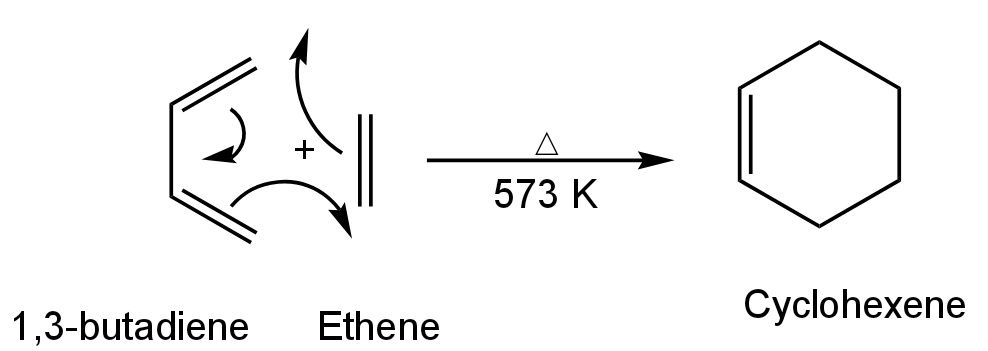
1, 3-butadiene reacts with ethylene to form
A. Benzene
B. Cyclohexane
C. Cyclohexene
D. 2, 3 dimethyl butane
Answer
220.2k+ views
Hint: Hydrocarbons containing two double bonds are called dienes. These are also called alkadienes. The reaction of 1,3-butadiene with ethylene involves the formation of a six-membered ring by the 1,4-addition of an alkene to a conjugated diene.
Complete Step by Step Answer:
Hydrocarbons containing two double bonds are called dienes. These are also called alkadienes.
These compounds are isomeric with alkynes.
1,3-butadiene is a conjugated diene or a single bond that intervenes with two double bonds. They have an arrangement of alternate single and double bonds.
The reaction of 1,3-butadiene with ethylene involves the formation of a six-membered ring by the 1,4-addition of an alkene to a conjugated diene. This reaction is known as the Diels-Alder reaction.
Alkene used is known as a dienophile and the product is known as Diels-Alder adduct. It is a cycloaddition reaction. Diels-Alder reaction is a 1,4 addition of ethene to 1,3-butadiene and also a 1,2 addition of butadiene to ethene. It is known as [4 + 2] cycloaddition leading to the formation of a six-membered ring. This six-membered ring is cyclohexene.
The reaction happens as follows:

Image: Diels-Alder reaction
So, 1, 3-butadiene reacts with ethylene to form cyclohexane.
So, option C is correct.
Note: Ethene and other simple alkenes normally are weak dienophiles and react with 1,3-butadiene only under drastic conditions and in low yield. But, when the hydrogen atoms in the diene are replaced with various electron-attracting groups such as chlorine or bromine, electron-donating groups the reaction happens on its own.
Complete Step by Step Answer:
Hydrocarbons containing two double bonds are called dienes. These are also called alkadienes.
These compounds are isomeric with alkynes.
1,3-butadiene is a conjugated diene or a single bond that intervenes with two double bonds. They have an arrangement of alternate single and double bonds.
The reaction of 1,3-butadiene with ethylene involves the formation of a six-membered ring by the 1,4-addition of an alkene to a conjugated diene. This reaction is known as the Diels-Alder reaction.
Alkene used is known as a dienophile and the product is known as Diels-Alder adduct. It is a cycloaddition reaction. Diels-Alder reaction is a 1,4 addition of ethene to 1,3-butadiene and also a 1,2 addition of butadiene to ethene. It is known as [4 + 2] cycloaddition leading to the formation of a six-membered ring. This six-membered ring is cyclohexene.
The reaction happens as follows:

Image: Diels-Alder reaction
So, 1, 3-butadiene reacts with ethylene to form cyclohexane.
So, option C is correct.
Note: Ethene and other simple alkenes normally are weak dienophiles and react with 1,3-butadiene only under drastic conditions and in low yield. But, when the hydrogen atoms in the diene are replaced with various electron-attracting groups such as chlorine or bromine, electron-donating groups the reaction happens on its own.
Recently Updated Pages
Difference Between Alcohol and Phenol: Structure, Tests & Uses

Class 12 Chemistry Mock Test Series for JEE Main – Free Online Practice

Electricity and Magnetism Explained: Key Concepts & Applications

JEE Energetics Important Concepts and Tips for Exam Preparation

JEE Isolation, Preparation and Properties of Non-metals Important Concepts and Tips for Exam Preparation

JEE Main 2021 July 25 Shift 1 Question Paper with Answer Key

Trending doubts
JEE Main 2026: Application Form Open, Exam Dates, Syllabus, Eligibility & Question Papers

Derivation of Equation of Trajectory Explained for Students

Hybridisation in Chemistry – Concept, Types & Applications

Understanding the Angle of Deviation in a Prism

How to Convert a Galvanometer into an Ammeter or Voltmeter

JEE Main Marking Scheme 2026- Paper-Wise Marks Distribution and Negative Marking Details

Other Pages
Solutions Class 12 Chemistry Chapter 1 CBSE Notes - 2025-26

NCERT Solutions For Class 12 Chemistry Chapter 1 Solutions - 2025-26

The D and F Block Elements Class 12 Chemistry Chapter 4 CBSE Notes - 2025-26

NCERT Solutions for Class 12 Chemistry Chapter Chapter 7 Alcohol Phenol and Ether

NCERT Solutions ForClass 12 Chemistry Chapter Chapter 8 Aldehydes Ketones And Carboxylic Acids

JEE Advanced Marks vs Ranks 2025: Understanding Category-wise Qualifying Marks and Previous Year Cut-offs




